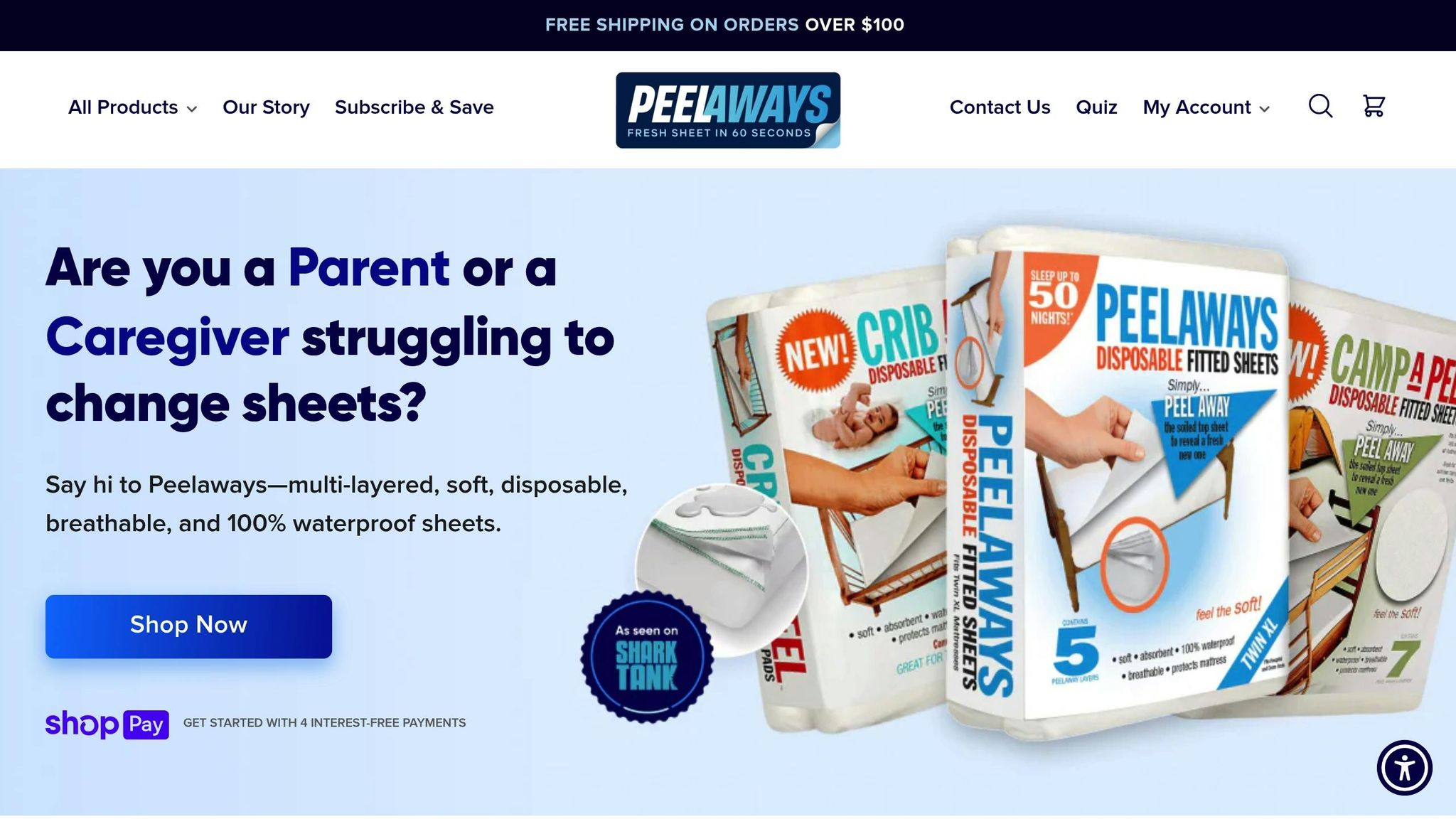Quick Guide: Managing Overnight Accidents in Children

Managing overnight accidents can feel challenging, but with the right approach, you can reduce stress for both you and your child. Here’s what you need to know:
- Causes: Bedwetting often stems from developmental factors, deep sleep, hormonal delays, constipation, or stress. It’s common and usually resolves with time.
- When to See a Doctor: Sudden accidents after months of dryness, frequent accidents past the typical age, or symptoms like fever or excessive thirst may require medical evaluation.
- Solutions: Use waterproof bedding like PeelAways disposable sheets to simplify cleanup, and pair them with absorbent nighttime products for added protection.
- Bedtime Routines: Limit fluids before bed, encourage bathroom visits, and maintain a consistent schedule to help regulate your child’s habits.
- Emotional Support: Stay calm, offer encouragement, and avoid punishment to build your child’s confidence during this phase.
Bedwetting Solutions: Causes, Tips & When to Seek Help for Your Child
Understanding Overnight Accidents: Causes and When to Seek Help
Overnight accidents can happen for a variety of reasons, and understanding these causes can help you provide better support. Recognizing what's typical and knowing when to seek professional advice are essential steps in addressing the issue. Let’s break down the common causes and highlight when it’s time to consult a healthcare provider.
Common Causes of Overnight Accidents
For many children, bedwetting is tied to developmental factors. Bladder control develops at different rates, and some kids simply need more time to stay dry through the night. The brain and bladder communication system - which wakes a child when the bladder is full - takes time to fully mature, and this timeline varies from child to child.
Deep sleep can also play a role. Some children sleep so soundly that they don’t wake up when their bladder signals it’s time to go. This tendency is often inherited, so if you or other family members experienced similar issues, your child might too.
Hormonal development is another factor. The body produces a hormone called antidiuretic hormone (ADH) to slow urine production during sleep. However, some children may not produce enough of this hormone early on, leading to more nighttime urine and, consequently, accidents.
Constipation can complicate things further. A full bowel can press against the bladder, reducing its capacity and increasing the likelihood of accidents. Addressing constipation often improves bladder control.
Emotional stress is another key contributor. Big changes - like starting school, moving, or family disruptions - can temporarily increase bedwetting. These stress-related episodes typically resolve as children adjust. Additionally, drinking large amounts of fluid close to bedtime heightens the risk of accidents, so shifting most fluid intake to earlier in the day can help.
When to Seek Medical Advice
While most bedwetting resolves naturally, certain signs suggest it’s time to consult a doctor. For instance, if your child suddenly starts bedwetting again after six months or more of dryness, this could point to underlying issues like a urinary tract infection, diabetes, or another medical condition. In such cases, a healthcare evaluation is recommended.
Frequent bedwetting beyond the usual developmental age may also warrant medical attention. While every child develops at their own pace, consistent accidents past the typical age for nighttime dryness might indicate hormonal or anatomical concerns.
Other warning signs include bedwetting accompanied by symptoms like fever, pain, excessive thirst, weight loss, or changes in bathroom habits. These could signal an infection or another health issue. Similarly, if your child experiences daytime accidents alongside nighttime ones - especially if they previously had good bladder control - it’s a good idea to seek a thorough evaluation.
Bedwetting can also affect your child’s emotional well-being. If it’s causing noticeable anxiety, withdrawal from activities, or regressive behaviors, consulting a pediatric counselor may help. They can provide emotional support and practical strategies to address both the accidents and the feelings surrounding them.
Above all, trust your instincts as a parent. While most cases resolve without medical intervention, seeking professional advice can offer reassurance and tailored solutions when needed. This guidance can also help inform choices about bedding and nighttime products, which we’ll explore later.
Choosing Waterproof Bedding Solutions
Managing overnight accidents can be challenging, but the right bedding solutions can make a world of difference. Waterproof bedding is an essential tool for protecting your mattress while simplifying cleanup. The key is finding options that balance effective protection with comfort, ensuring your child gets a good night's rest - and you get peace of mind. Let’s explore how a tailored waterproof bedding system can help.
Benefits of Waterproof Bedding
Protects your mattress: A mattress is a significant investment, and once moisture seeps in, it can lead to lingering odors and bacteria growth that are tough to eliminate. Waterproof bedding acts as a barrier, keeping your mattress dry and extending its lifespan.
Simplifies cleanup: Without waterproof bedding, accidents often mean stripping the bed and washing multiple layers of linens. With a waterproof layer, you can quickly remove and replace the soiled sheet, saving time and effort.
Promotes hygiene: Moisture trapped in a mattress can encourage bacteria, mold, and dust mites - common triggers for allergies and respiratory issues, especially in children. A waterproof barrier helps create a healthier sleeping environment by preventing moisture buildup.
Reduces stress: Knowing that accidents can be managed quickly and easily helps create a calm atmosphere for both parents and children. This simplicity can even support a child’s emotional well-being by minimizing the embarrassment or frustration that might come with nighttime accidents.
Overview of PeelAways Disposable Waterproof Bed Sheets

PeelAways offers a practical and innovative solution to make managing accidents easier. These disposable fitted sheets feature a unique multi-layer design, with 5 to 7 absorbent layers depending on the size. When an accident happens, you simply peel away the top layer to reveal a fresh, clean sheet underneath. No need to lift the mattress, rush to the laundry, or worry about cross-contamination.
Comfortable materials: Each layer is 100% waterproof yet breathable, avoiding the stiff, plastic-like texture that can disrupt sleep. The soft fabric feels similar to regular sheets, helping children maintain their usual sleep routine.
Eco-friendly design: For families mindful of the environment, PeelAways uses chemical-free materials and offers compostable and biodegradable options, reducing their environmental footprint.
Versatile use: These sheets aren’t just for kids. They’re also ideal for potty training, managing illness, elder care, and even in healthcare settings. Their peel-away design helps prevent cross-contamination while maintaining the comfort of traditional bedding.
Cost efficiency: While the upfront price may seem higher than traditional sheets, the savings on laundry, water, detergent, and potential mattress replacements make them a smart choice for families dealing with frequent accidents.
PeelAways combines convenience, comfort, and thoughtful design to provide a stress-free solution for managing overnight accidents, making them a worthwhile addition to any household.
Using Absorbent Nighttime Products
Absorbent products work hand-in-hand with waterproof bedding to keep your child dry and comfortable throughout the night. While waterproof sheets like PeelAways protect the mattress, absorbent products focus on ensuring your child stays cozy and undisturbed. The right combination can make a world of difference, turning restless nights into peaceful sleep for everyone. Let’s dive into the main types of absorbent products and how they can fit into your routine.
Types of Absorbent Nighttime Products
Disposable absorbent underwear is a go-to option for kids who occasionally have nighttime accidents. These have come a long way from the bulky designs of the past. Now, they’re sleek, effective, and styled to resemble regular underwear, making them a discreet choice for children who are mostly potty-trained but need some extra help during the night.
Reusable training pants provide an eco-conscious and budget-friendly solution, especially for frequent accidents. Made with layers of absorbent fabric and a waterproof outer layer, they’re a great alternative to disposables. However, they do require more upkeep since they need regular washing.
Mattress protectors with absorbent tops offer dual benefits: a waterproof barrier paired with an absorbent layer that wicks moisture away from your child’s body. These are particularly useful when paired with layered bedding solutions like PeelAways, adding an extra layer of security and comfort.
Absorbent bed pads are designed to be placed directly on top of the sheets for targeted protection. These are especially handy for kids who tend to move around a lot while sleeping, as they provide coverage exactly where it’s needed most.
Overnight-specific products are built to handle the extended hours of sleep with higher absorption capacity. They’re designed with extra absorbent material to manage the longer intervals between changes, making them a reliable option for nighttime use.
Understanding these options can help you create a setup that prioritizes your child’s comfort and ensures better sleep for everyone.
How Absorbent Products Improve Comfort
High-quality absorbent products are designed to wick moisture away from the skin quickly, distributing it evenly throughout the absorbent core. This helps prevent skin irritation and avoids the discomfort that could wake your child during the night. Many of these products also promote airflow for temperature regulation and include odor-neutralizing features to maintain a fresh sleeping environment.
Modern designs now mimic the fit and feel of regular underwear, with soft materials and elastic bands that don’t dig into the skin. This ensures that children feel secure and confident, knowing accidents won’t lead to wet pajamas or uncomfortable situations. The psychological comfort this provides is just as vital as the physical benefits, helping your child sleep more soundly.
When paired with multi-layer protection systems like PeelAways, these products create an effective setup that manages accidents seamlessly while keeping your child comfortable all night long.
sbb-itb-45288fe
Creating Effective Bedtime Routines
A consistent bedtime routine helps signal to your child's body that it's time to wind down and prepare for sleep. When children know what to expect each night, their bodies naturally adjust, helping regulate bathroom habits and sleep cycles. This predictability can reduce nighttime accidents and foster a sense of security, leading to better rest for the entire family. Paired with the right bedding solutions, a structured routine can make a big difference in overnight success.
The key is to create routines that align with your child's natural rhythms. Kids thrive on structure, and a well-thought-out bedtime routine helps their brain and bladder prepare for a full night of rest. This preparation is essential for minimizing accidents and ensuring everyone sleeps soundly.
Practical Steps for Bedtime Preparation
To complement protective bedding, try incorporating these bedtime habits:
- Limit evening drinks: Stop offering drinks 90 to 120 minutes before bedtime, depending on your child's age. Younger kids may need the shorter window, while older children can handle a longer cutoff. Encourage hydration throughout the day and gradually reduce fluids in the evening instead of cutting them off abruptly.
- Build in bathroom visits: Make it a habit for your child to use the bathroom about 15–30 minutes before getting into bed. This timing gives their bladder a chance to settle. A two-step bathroom routine - once at the start of the bedtime process and again right before bed - can be especially effective.
- Stick to consistent sleep and wake times: Try to keep your child's schedule within a 30-minute window each day. This consistency reinforces their natural circadian rhythm, which plays a role in hormone production and nighttime urine concentration.
- Create a calm environment: A soothing pre-bedtime routine can help reduce stress and support bladder control. Dim the lights, avoid stimulating activities like roughhousing or exciting TV shows, and focus on quiet, relaxing activities like reading or gentle stretching. This transition helps signal to your child that bedtime is near.
- Set the room temperature: Keep the bedroom between 68–70°F for optimal sleep comfort. Restless sleep caused by being too hot or too cold can increase the likelihood of accidents. Choose breathable sleepwear appropriate for the season to help your child stay comfortable.
Using Positive Reinforcement
Beyond physical routines, emotional support plays a big role in building your child's confidence during this phase.
- Praise effort, not just outcomes: Celebrate small wins, like remembering to use the bathroom before bed or helping with cleanup, rather than focusing solely on dry nights. This helps build confidence without creating unnecessary pressure.
- Avoid punishment or shame: Negative emotions like stress or anxiety can disrupt sleep and bladder control. Children who feel worried about disappointing their parents may have more accidents due to these heightened emotions. Stay supportive and understanding.
- Introduce simple rewards: A reward system can encourage positive habits. Use small, immediate rewards like sticker charts for completing bathroom visits, extra story time for cooperative bedtime routines, or a special breakfast after a successful night. The goal is to reinforce good behaviors without adding pressure.
- Use encouraging language: Phrases like "You're learning to listen to your body" or "You handled that cleanup like a pro" can boost your child's self-esteem and highlight their growing independence.
- Stay calm during setbacks: Your reaction sets the tone for how your child views accidents. Staying calm and composed during cleanup shows your child that these situations are manageable and temporary. This approach helps them feel supported rather than discouraged.
It's important to remember that every child develops at their own pace. Some kids may respond well to visual schedules that outline their bedtime routine, while others might prefer verbal reminders. Pay attention to what motivates your child and adjust your approach as needed. The goal is to create a routine that feels supportive and stress-free, setting the stage for restful nights and growing confidence.
Addressing Emotional and Medical Factors
If accidents continue despite consistent routines and appropriate bedding, it’s time to consider emotional and medical factors that might be contributing to the issue. Sometimes, what seems like a simple bedtime hiccup could be your child’s way of responding to stress or even a sign of an underlying medical condition.
Stress, for instance, can influence both behavior and physical functions. A child who has been consistently dry may suddenly experience setbacks due to emotional stress or medical challenges that make bladder control more difficult.
Identifying Emotional Triggers
Major life changes often play a role in nighttime accidents. Events like moving to a new house, starting a new school, welcoming a sibling, or experiencing parental separation can create stress that affects sleep and bladder control. Even positive changes, such as starting kindergarten or joining a new activity, can feel overwhelming and lead to temporary setbacks.
School-related stress is another common trigger. Children might face anxiety from bullying, academic challenges, social struggles, or adjusting to a new teacher. While they may seem fine during the day, they could be suppressing their worries, which resurface at bedtime when they’re trying to relax.
Trauma or significant emotional events can also lead to accidents. The loss of a loved one or pet, witnessing an accident, or experiencing any form of abuse can cause regression. In these cases, accidents may reflect the child’s emotional overwhelm and their body’s response to stress.
It can help to monitor the timing of accidents. If your child has been dry for months and suddenly starts having frequent accidents, think about what might have changed in their life. A simple log noting wet nights, stressful events, changes in routine, or emotional outbursts during the day can provide valuable insights.
Changes in communication and behavior might also indicate emotional stress. Children dealing with anxiety may become clingy, have trouble sleeping, show appetite changes, or act irritable. Others might withdraw or act out more than usual.
If you suspect emotional factors, focus on creating a sense of safety and support. Spend extra one-on-one time with your child, read books together about the changes they’re experiencing, and reassure them that big feelings are normal and temporary. Avoid pressuring them about staying dry, and instead emphasize your support and understanding.
If emotional factors alone don’t explain the accidents, it’s worth considering medical causes.
Seeking Professional Support
For children who resume accidents after being consistently dry for months, especially after age 7, consulting a pediatrician is a wise step. While every child develops at their own pace, persistent nighttime wetting at this age might indicate an underlying medical issue that can be addressed.
Urinary tract infections (UTIs) are a common cause of sudden accidents. Symptoms include burning during urination, frequent trips to the bathroom, cloudy or strong-smelling urine, or fever. Constipation can also play a role by pressing on the bladder and reducing its capacity. If your child has fewer than three bowel movements per week or experiences hard, painful stools, addressing this could resolve the issue. Sleep disorders, such as sleep apnea, can contribute to bedwetting, especially if your child sleeps deeply or snores loudly. Diabetes may cause increased nighttime urination, along with symptoms like excessive thirst and unexplained weight loss. Hormonal imbalances affecting antidiuretic hormone (ADH) production can lead to larger amounts of urine at night.
When visiting your pediatrician, come prepared with detailed information. Note how often accidents occur, whether your child wakes up during them or sleeps through, any related symptoms, family history of bedwetting, and what strategies you’ve already tried. This information will help the doctor determine if further testing or a specialist referral is necessary.
If emotional factors seem to be a significant part of the issue, consulting a mental health professional can be helpful. Child psychologists or counselors experienced in working with young children can assist your child in processing emotions and developing coping strategies. Having a neutral adult to talk to can be especially comforting during times of family stress or major transitions.
Ultimately, trust your instincts as a parent. If something feels off about your child’s pattern of accidents or you notice changes in their behavior, sleep, or overall well-being, don’t hesitate to seek professional advice. Early action often leads to quicker solutions and less stress for everyone involved.
Conclusion: Making Overnight Accident Management Easier
Managing overnight accidents doesn’t have to be overwhelming. By combining protective bedding, absorbent products, and consistent routines, parents can create a smoother nightly process that minimizes stress for everyone.
One standout solution is PeelAways disposable waterproof bed sheets. Their multi-layer design allows parents to remove a soiled layer and reveal a clean sheet underneath in under a minute - no need to strip the bed or scrub the mattress [1]. This simple yet effective product can be a game-changer for busy families.
Pairing these sheets with high-quality absorbent nighttime products and a bedtime routine that includes scheduled bathroom trips and positive reinforcement can transform disruptive nights into manageable ones. Plus, letting kids take charge of minor accidents with peel-away sheets can help build their independence and confidence.
Every child’s journey toward nighttime dryness is unique, and occasional setbacks are part of the process. Whether your child is still mastering dryness or adjusting due to emotional or medical changes, having dependable tools in place can make a world of difference. With this well-rounded approach, families can focus on supporting their child’s growth while ensuring everyone gets the rest they need.
FAQs
What signs might indicate that my child's bedwetting is caused by a medical issue rather than normal development?
Bedwetting is often a natural part of growing up, but sometimes it can signal an underlying medical concern. Keep an eye out for signs like unusually large amounts of urine, frequent urinary tract infections, or ongoing constipation. Issues such as a small or overactive bladder, hormonal shifts, or sleep disorders like sleep apnea might also contribute.
If your child suddenly starts bedwetting after staying dry for a long time or shows other symptoms like pain, fever, or excessive thirst, it’s wise to reach out to a pediatrician. Pinpointing and addressing any medical causes early can make a significant difference in managing the situation.
How can I support my child emotionally with bedwetting and help protect their self-esteem?
Bedwetting is a normal part of growing up and isn’t something your child can control, so it’s essential to reassure them that there’s no need to feel embarrassed. Let them know it’s a phase that many kids experience, and they’re not alone. Avoid reacting with frustration or punishment, as this can make them feel worse and add unnecessary pressure.
Instead, focus on creating a safe space where they can share their feelings openly. Highlight their strengths and celebrate their accomplishments in other areas to boost their confidence. Establishing a calm and consistent bedtime routine can also help ease any anxiety that might play a role in bedwetting. Most importantly, remind them that this is a temporary challenge, and you’ll face it together as a team.
What’s the difference between disposable and reusable training pants, and how can I choose the right one for my child?
When it comes to potty training, disposable training pants are all about convenience. Made with super-absorbent materials, they’re great for handling overnight accidents or those unpredictable moments during the day. Since they’re single-use, they’re perfect for travel or when life gets busy. But, as with all disposable products, they contribute to more waste.
Reusable training pants take a different approach. Made from washable cloth, they’re designed to be a more eco-friendly and budget-friendly choice in the long run. They look and feel a lot like regular underwear, which can help kids transition more easily while also cutting down on waste - an appealing option for families aiming to be more environmentally conscious.
So, how do you decide? Think about your child’s comfort, your budget, and what fits your lifestyle. Disposable pants are a lifesaver for convenience and overnight use, while reusable ones are ideal for families focused on reducing waste and saving money over time. The best choice is the one that aligns with your child’s needs and your daily rhythm.
Related posts
Comments
0

SAVE MONEY & WATER
Professionals & Institutions save a fortune on labor/laundry.

SUPERIOR COMFORT
The first thing our customers notice is how soft our sheets are.

100% WATERPROOF
Each layer is 100% Waterproof, perfect for spills and accidents

SAVE TIME
Change the sheet in under 1 minute without stripping the bed.




Leave a comment